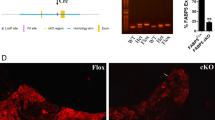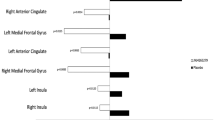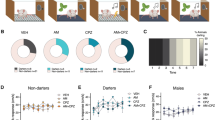Abstract
The endocannabinoid-inactivating enzyme, fatty acid amide hydrolase (FAAH), and the transient receptor potential vanilloid type-1 (TRPV1) channel are new targets for the development of anxiolytic drugs. We studied the effect on anxiety-like behavior in the elevated plus maze of a dual FAAH/TRPV1 blocker, N-arachidonoyl-serotonin (AA-5-HT). In male C57BL/6J mice, acute intraperitoneal administration of AA-5-HT (0.1–2.5 mg/kg) increased both the time spent and the number of entries in the open arm, while being inactive at the highest dose tested (5 mg/kg). AA-5-HT was more potent than selective blockers of FAAH or TRPV1 (URB597 and SB366791, respectively). In male Swiss mice, AA-5-HT had to be administered chronically to observe an anxiolytic effect at an intermediate dose (2.5 mg/kg), the highest dose (5 mg/kg) being anxiogenic, and 1 mg/kg being ineffective. In both strains, the anxiolytic effects of AA-5-HT were paralleled by elevation of brain endocannabinoid levels and were reversed by per se inactive doses of the cannabinoid receptors of type-1 (CB1) receptor antagonist AM251, or the TRPV1 agonist, olvanil. Immunohistochemical localization of CB1 and TRPV1 receptors was observed in mouse prefrontal cortex, nucleus accumbens, amygdala, and hippocampus. Simultaneous ‘indirect’ activation of CB1 receptors following FAAH inhibition, and antagonism at TRPV1 receptors might represent a new therapeutic strategy against anxiety.
Similar content being viewed by others
Log in or create a free account to read this content
Gain free access to this article, as well as selected content from this journal and more on nature.com
or
References
Ahluwalia J, Urban L, Bevan S, Nagy I (2003). Anandamide regulates neuropeptide release from capsaicin-sensitive primary sensory neurons by activating both the cannabinoid 1 receptor and the vanilloid receptor 1 in vitro. Eur J Neurosci 17: 2611–2618.
Bisogno T, Cascio MG, Saha B, Mahadevan A, Urbani P, Minassi A et al (2006). Development of the first potent and specific inhibitors of endocannabinoid biosynthesis. Biochim Biophys Acta 1761: 205–212.
Bisogno T, Di Marzo V (2007). Short- and long-term plasticity of the endocannabinoid system in neuropsychiatric and neurological disorders. Pharmacol Res 56: 428–442.
Bisogno T, Melck D, De Petrocellis L, Bobrov MYu, Gretskaya NM, Bezuglov VV et al (1998). Arachidonoylserotonin and other novel inhibitors of fatty acid amide hydrolase. Biochem Biophys Res Commun 248: 515–522.
Blankman JL, Simon GM, Cravatt BF (2007). A comprehensive profile of brain enzymes that hydrolyze the endocannabinoid 2-arachidonoylglycerol. Chem Biol 14: 1347–1356.
Consoli D, Leggio GM, Mazzola C, Micale V, Drago F (2007). Behavioral effects of the beta3 adrenoceptor agonist SR58611A: is it the putative prototype of a new class of antidepressant/anxiolytic drugs? Eur J Pharmacol 573: 139–147.
Crawley JN, Belknap JK, Collins A, Crabbe JC, Frankel W, Henderson N et al (1997). Behavioral phenotypes of inbred mouse strains: implications and recommendations for molecular studies. Psychopharmacology 132: 107–124.
Cristino L, De Petrocellis L, Pryce G, Baker D, Guglielmotti V, Di Marzo V (2006). Immunohistochemical localization of cannabinoid type 1 and vanilloid transient receptor potential vanilloid type 1 receptors in the mouse brain. Neuroscience 139: 1405–1415.
de Lago E, Petrosino S, Valenti M, Morera E, Ortega-Gutierrez S, Fernandez-Ruiz J et al (2005). Effect of repeated systemic administration of selective inhibitors of endocannabinoid inactivation on rat brain endocannabinoid levels. Biochem Pharmacol 70: 446–452.
De Petrocellis L, Bisogno T, Davis JB, Pertwee RG, Di Marzo V (2000). Overlap between the ligand recognition properties of the anandamide transporter and the VR1 vanilloid receptor: inhibitors of anandamide uptake with negligible capsaicin-like activity. FEBS Lett 483: 52–56.
Devane WA, Hanus L, Breuer A, Pertwee RG, Stevenson LA, Griffin G et al (1992). Isolation and structure of a brain constituent that binds to the cannabinoid receptor. Science 258: 1946–1949.
Di Marzo V, Bisogno T, De Petrocellis L (2007). Endocannabinoids and related compounds: walking back and forth between plant natural products and animal physiology. Chem Biol 14: 741–756.
Di Marzo V, Capasso R, Matias I, Aviello G, Petrosino S, Borrelli F et al (2008). The role of endocannabinoids in the regulation of gastric emptying: alterations in mice fed a high-fat diet. Br J Pharmacol 153: 1272–1280.
Di Marzo V, De Petrocellis L, Fezza F, Ligresti A, Bisogno T (2002). Anandamide receptors. Prostaglandins Leukot Essent Fatty Acids 66: 377–391.
Di Marzo V, Maccarrone M (2008). FAAH and anandamide: is 2-AG really the odd one out? Trends Pharmacol Sci 29: 229–233.
File SE (1992). Usefulness of animal models with newer anxiolytics. Clin Neuropharmacol 15: 525A–526A.
Fowler CJ, Tiger G, López-Rodríguez ML, Viso A, Ortega-Gutiérrez S, Ramos JA (2003). Inhibition of fatty acid amidohydrolase, the enzyme responsible for the metabolism of the endocannabinoid anandamide, by analogues of arachidonoyl-serotonin. J Enzyme Inhib Med Chem 18: 225–231.
Freund TF, Katona I, Piomelli D (2003). Role of endogenous cannabinoids in synaptic signaling. Physiol Rev 83: 1017–1066.
Griebel G, Belzung C, Perrault G, Sanger DJ (2000). Differences in anxiety-related behaviours and in sensitivity to diazepam in inbred and outbred strains of mice. Psychopharmacology 148: 164–170.
Hermann H, De Petrocellis L, Bisogno T, Schiano Moriello A, Lutz B, Di Marzo V (2003). Dual effect of cannabinoid CB1 receptor stimulation on a vanilloid VR1 receptor-mediated response. Cell Mol Life Sci 60: 607–616.
Hohmann AG, Suplita II RL (2006). Endocannabinoid mechanisms of pain modulation. AAPS J 8: E693–E708.
Huang SM, Bisogno T, Trevisani M, Al-Hayani A, De Petrocellis L, Fezza F et al (2002). An endogenous capsaicin-like substance with high potency at recombinant and native vanilloid VR1 receptors. Proc Natl Acad Sci USA 99: 8400–8405.
Hwang D (2000). Fatty acids and immune responses: a new perspective in searching for clues to mechanism. Annu Rev Nutr 20: 431–456.
Kasckow JW, Mulchahey JJ, Geracioti Jr TD (2004). Effects of the vanilloid agonist olvanil and antagonist capsazepine on rat behaviors. Prog Neuropsychopharmacol Biol Psychiatry 28: 291–295.
Kathuria S, Gaetani S, Fegley D, Valiño F, Duranti A, Tontini A et al (2003). Modulation of anxiety through blockade of anandamide hydrolysis. Nat Med 9: 76–81.
Kim SR, Lee da Y, Chung ES, Oh UT, Kim SU, Jin BK (2007). Roles of transient receptor potential vanilloid subtype 1 and cannabinoid type 1 receptors in the brain: neuroprotection versus neurotoxicity. Mol Neurobiol 35: 245–254.
Lafenetre P, Chaouloff F, Marsicano G (2007). The endocannabinoid system in the processing of anxiety and fear and how CB1 receptors may modulate fear extinction. Pharmacol Res 56: 367–381.
Lee J, Di Marzo V, Brotchie JM (2006). A role for vanilloid receptor 1 (TRPV1) and endocannabinnoid signalling in the regulation of spontaneous and L-DOPA induced locomotion in normal and reserpine-treated rats. Neuropharmacology 51: 557–565.
Leggio GM, Micale V, Drago F (2008). Increased sensitivity to antidepressants of D(3) dopamine receptor-deficient mice in the forced swim test (FST). Eur Neuropsychopharmacol 18: 271–277.
Lepicard EM, Joubert C, Hagneau I, Perez-Diaz F, Chapouthier G (2000). Differences in anxiety-related behavior and response to diazepam in BALB/cByJ and C57BL/6J strains of mice. Pharmacol Biochem Behav 67: 739–748.
Lutz B (2007). The endocannabinoid system and extinction learning. Mol Neurobiol 36: 92–101.
Maccarrone M, Rossi S, Bari M, De Chiara V, Fezza F, Musella A et al (2008). Anandamide inhibits metabolism and physiological actions of 2-arachidonoylglycerol in the striatum. Nat Neurosci 11: 152–159.
Maione S, Bisogno T, de Novellis V, Palazzo E, Cristino L, Valenti M et al (2006). Elevation of endocannabinoid levels in the ventrolateral periaqueductal grey through inhibition of fatty acid amide hydrolase affects descending nociceptive pathways via both cannabinoid receptor type 1 and transient receptor potential vanilloid type-1 receptors. J Pharmacol Exp Ther 316: 969–982.
Maione S, De Petrocellis L, de Novellis V, Moriello AS, Petrosino S, Palazzo E et al (2007). Analgesic actions of N-arachidonoyl-serotonin, a fatty acid amide hydrolase inhibitor with antagonistic activity at vanilloid TRPV1 receptors. Br J Pharmacol 150: 766–781.
Marinelli S, Di Marzo V, Florenzano F, Fezza F, Viscomi MT, van der Stelt M et al (2007). N-arachidonoyl-dopamine tunes synaptic transmission onto dopaminergic neurons by activating both cannabinoid and vanilloid receptors. Neuropsychopharmacology 32: 298–308.
Marinelli S, Pascucci T, Bernardi G, Puglisi-Allegra S, Mercuri NB (2005). Activation of TRPV1 in the VTA excites dopaminergic neurons and increases chemical- and noxious-induced dopamine release in the nucleus accumbens. Neuropsychopharmacology 30: 864–870.
Marsch R, Foeller E, Rammes G, Bunck M, Kössl M, Holsboer F et al (2007). Reduced anxiety, conditioned fear, and hippocampal long-term potentiation in transient receptor potential vanilloid type 1 receptor-deficient mice. J Neurosci 27: 832–839.
Marsicano G, Wotjak CT, Azad SC, Bisogno T, Rammes G, Cascio MG et al (2002). The endogenous cannabinoid system controls extinction of aversive memories. Nature 418: 530–534.
Mechoulam R, Ben-Shabat S, Hanus L, Ligumsky M, Kaminski NE, Schatz AR et al (1995). Identification of an endogenous 2-monoglyceride, present in canine gut, that binds to cannabinoid receptors. Biochem Pharmacol 50: 83–90.
Moreira FA, Kaiser N, Monory K, Lutz B (2008). Reduced anxiety-like behaviour induced by genetic and pharmacological inhibition of the endocannabinoid-degrading enzyme fatty acid amide hydrolase (FAAH) is mediated by CB1 receptors. Neuropharmacology 54: 141–150.
Morgese MG, Cassano T, Cuomo V, Giuffrida A (2007). Anti-dyskinetic effects of cannabinoids in a rat model of Parkinson's disease: role of CB(1) and TRPV1 receptors. Exp Neurol 208: 110–119.
Movahed P, Jonsson BA, Birnir B, Wingstrand JA, Jorgensen TD, Ermund A et al (2005). Endogenous unsaturated C18 N-acylethanolamines are vanilloid receptor (TRPV1) agonists. J Biol Chem 280: 38496–38504.
Naderi N, Haghparast A, Saber-Tehrani A, Rezaii N, Alizadeh AM, Khani A et al (2008). Interaction between cannabinoid compounds and diazepam on anxiety-like behaviour of mice. Pharmacol Biochem Behav 89: 64–75.
Naidu PS, Varvel SA, Ahn K, Cravatt BF, Martin BR, Lichtman AH (2007). Evaluation of fatty acid amide hydrolase inhibition in murine models of emotionality. Psychopharmacology 192: 61–70.
Ortar G, Cascio MG, De Petrocellis L, Morera E, Rossi F, Schiano-Moriello A et al (2007). New N-arachidonoylserotonin analogues with potential ‘dual’ mechanism of action against pain. J Med Chem 50: 6554–6569.
Oz M (2006). Receptor-independent actions of cannabinoids on cell membranes: Focus on endocannabinoids. Pharmacol Ther 111: 114–144.
Patel S, Hillard CJ (2006). Pharmacological evaluation of cannabinoid receptor ligands in a mouse model of anxiety: further evidence for an anxiolytic role for endogenous cannabinoid signaling. J Pharmacol Exp Ther 318: 304–311.
Pellow S, Chopin P, File SE (1985). Are the anxiogenic effects of yohimbine mediated by its action at benzodiazepine receptors? Neurosci Lett 55: 5–9.
Rubino T, Realini N, Castiglioni C, Guidali C, Viganó D, Marras E et al (2008). Role in Anxiety Behavior of the Endocannabinoid System in the Prefrontal Cortex. Cereb Cortex 18: 1292–1301.
Starowicz K, Cristino L, Di Marzo V (2008). TRPV1 receptors in the central nervous system: potential for previously unforeseen therapeutic applications. Curr Pharm Des 14: 42–54.
Starowicz K, Maione S, Cristino L, Palazzo E, Marabese I, Rossi F et al (2007b). Tonic endovanilloid facilitation of glutamate release in brainstem descending antinociceptive pathways. J Neurosci 27: 13739–13749.
Starowicz K, Nigam S, Di Marzo V (2007a). Biochemistry and pharmacology of endovanilloids. Pharmacol Ther 114: 13–33.
Steiner MA, Wanisch K, Monory K, Marsicano G, Borroni E, Bächli H et al (2008). Impaired cannabinoid receptor type 1 signaling interferes with stress-coping behavior in mice. Pharmacogenomics J 8: 196–208.
Sugiura T, Kondo S, Sukagawa A, Nakane S, Shinoda A, Itoh K et al (1995). 2-Arachidonoylglycerol: a possible endogenous cannabinoid receptor ligand in brain. Biochem Biophys Res Commun 215: 89–97.
Tzavara ET, Li DL, Moutsimilli L, Bisogno T, Di Marzo V, Phebus LA et al (2006). Endocannabinoids activate transient receptor potential vanilloid 1 receptors to reduce hyperdopaminergia-related hyperactivity: therapeutic implications. Biol Psychiatry 59: 508–515.
van der Stelt M, Mazzola C, Esposito G, Matias I, Petrosino S, De Filippis D et al (2006). Endocannabinoids and beta-amyloid-induced neurotoxicity in vivo: effect of pharmacological elevation of endocannabinoid levels. Cell Mol Life Sci 63: 1410–1424.
Van Gaal L, Pi-Sunyer X, Després JP, McCarthy C, Scheen A (2008). Efficacy and safety of rimonabant for improvement of multiple cardiometabolic risk factors in overweight/obese patients: pooled 1-year data from the Rimonabant in Obesity (RIO) program. Diabetes Care 31 (Suppl 2): S229–S240.
Viveros MP, Marco EM, Llorente R, López-Gallardo M (2007). Endocannabinoid system and synaptic plasticity: implications for emotional responses. Neural Plast 2007: 52908.
Zygmunt PM, Petersson J, Andersson DA, Chuang H, Sørgård M, Di Marzo V et al (1999). Vanilloid receptors on sensory nerves mediate the vasodilator action of anandamide. Nature 400: 452–457.
Acknowledgements
These experiments were supported in part by the PhD International School Program in Neuropharmacology, University of Catania Medical School. We thank Dr C Wotjak, Max Planck Institute of Psychiatry, Munich, Germany, for the gift of perfused TRPV1 knockout mouse brains. Technical assistance from Mr Davide Castelluccio is also acknowledged.
Author information
Authors and Affiliations
Corresponding author
Additional information
Disclosures/Conflicts of interest
The authors declare that they have no conflicting interests.
Rights and permissions
About this article
Cite this article
Micale, V., Cristino, L., Tamburella, A. et al. Anxiolytic Effects in Mice of a Dual Blocker of Fatty Acid Amide Hydrolase and Transient Receptor Potential Vanilloid Type-1 Channels. Neuropsychopharmacol 34, 593–606 (2009). https://doi.org/10.1038/npp.2008.98
Received:
Revised:
Accepted:
Published:
Issue date:
DOI: https://doi.org/10.1038/npp.2008.98
Keywords
This article is cited by
-
Potential application of endocannabinoid system agents in neuropsychiatric and neurodegenerative diseases—focusing on FAAH/MAGL inhibitors
Acta Pharmacologica Sinica (2020)
-
Cannabinoids, TRPV and nitric oxide: the three ring circus of neuronal excitability
Brain Structure and Function (2020)
-
The potential value of capsaicin in modulating cognitive functions in a rat model of streptozotocin-induced Alzheimer’s disease
The Egyptian Journal of Neurology, Psychiatry and Neurosurgery (2019)
-
Opposing roles of dorsomedial hypothalamic CB1 and TRPV1 receptors in anandamide signaling during the panic-like response elicited in mice by Brazilian rainbow Boidae snakes
Psychopharmacology (2019)
-
Interaction between interleukin-1β and type-1 cannabinoid receptor is involved in anxiety-like behavior in experimental autoimmune encephalomyelitis
Journal of Neuroinflammation (2016)



